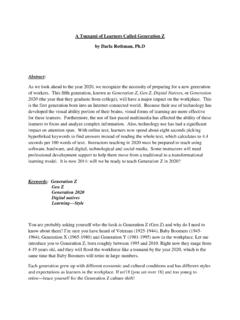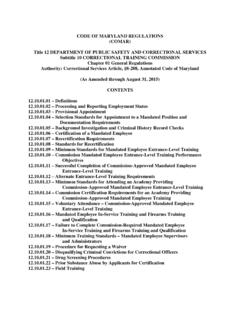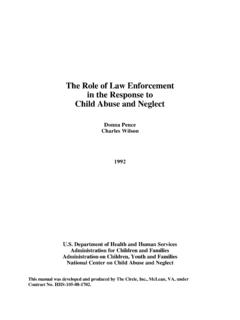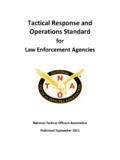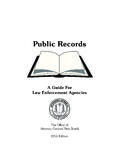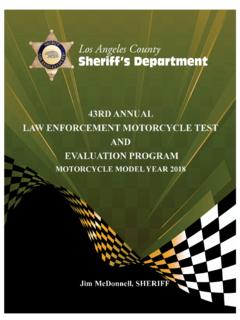Transcription of MODEL POLICIES FOR LAW ENFORCEMENT IN MARYLAND …
1 MODEL POLICIES FOR LAW ENFORCEMENT IN MARYLAND February 26, 1999 Re-Issued: January 8, 2007 Revised: June 1, 2000 Revised: December 18, 2000 Addition: May 21, 2001 Addition: November 18, 2002 Reformatted: February 24, 2004 Addition: July 1, 2004 Addition: September 27, 2007 2 TABLE OF CONTENTS Notices 3 Advisory Board 4 Background 5 Use of Force 6 Emergency Vehicle Pursuit Operation 9 Evidence
2 12 Employment Standards 15 Training Standards 17 Handling of Juveniles 19 Domestic Violence Investigations 22 Sexual Assault Investigations 24 Investigations of Misconduct
3 27 Inter-Agency Notification 30 Management of Informants 31 Release of Information 33 Ride-Along Program 36 Prisoner Transport 38 Reporting Requirements 40 Discrimination and Sexual Harassment
4 42 Second and Off-Duty Firearms 45 Computers and Electronic Databases 47 Documentation of Calls for Service 48 Multi-Jurisdictional Task Forces 49 Needle Stick Injury 50 Investigative and ENFORCEMENT Stops (added 5-21-01) 53 Interviews and Interrogations (added 11-18-02) 56 Ethics in Law ENFORCEMENT (added 7-1-04) 60 Domestic Violence by Law ENFORCEMENT Officer 67 (added 7-1-04)
5 The National Incident Management System (NIMS): 71 A Formal Recognition Eyewitness Identification (added 9-27-07) 74 3 This project was supported by Grant # DLE-97-395, awarded by the Bureau of Justice Assistance, Office of Justice Programs, Department of Justice. The Assistant Attorney General, Office of Justice Programs, coordinates the activities of the following program offices and bureaus: Bureau of Justice Assistance, Bureau of Justice Statistics, National Institute of Justice, Office of Juvenile Justice and Delinquency Prevention, and the Office of Victims of Crime.
6 Points of view or opinions contained within this document are those of the author and do not necessarily represent the official position or POLICIES of the Department of Justice. All previous criminal law citation references in this policy manual to the former Article 27 of the Annotated Code of MARYLAND have been converted to reflect their current citation listings under the new Criminal Law and Criminal Procedure Articles of the Annotated Code. 4 ADVISORY BOARD The individuals listed below constitute the original panel that was responsible for the development and distribution of the MODEL Polices for Law ENFORCEMENT in MARYLAND .
7 As the manual was expanded to include POLICIES addressing emerging law ENFORCEMENT issues, many additional individuals contributed their knowledge and expertise. Thanks go out to all those who have participated in the continuing review and development of the manual. Patrick L. Bradley Executive Director MARYLAND Police and Correctional Training Commissions Jon Burrell Executive Director Local Government Insurance Trust Colonel Steven Crumrine MARYLAND Chiefs of Police Association Sheriff Thomas Duncan President MARYLAND Sheriffs Association Donna Haynes President MARYLAND Law ENFORCEMENT Officers, Inc.
8 Daniel Lee Research Associate University of MARYLAND Center for Applied Policy Studies Lieutenant Donald Pike, Jr. President Chesapeake Region Law ENFORCEMENT Accreditation Alliance Charles Wellford Director University of MARYLAND Center for Applied Policy Studies 5 BACKGROUND The development of MODEL POLICIES for Law ENFORCEMENT in MARYLAND was examined by the Police Training Commission in the early 1990's as it considered the long term goals of the Commission. While the Commission believed that MODEL POLICIES could limit a police agency s exposure to liability and unsafe working conditions, it did not endorse any specific POLICIES .
9 It was expected that these MODEL POLICIES would be distributed to police agencies throughout MARYLAND and that agencies with existing POLICIES could compare their own policy to the MODEL . Where the MODEL policy was more comprehensive or suitable, it could be adopted or modified to meet the needs of the particular agency. For agencies without written policy, the models could be used to develop comprehensive POLICIES in those agencies. In 1998, the MARYLAND Police and Correctional Training Commissions submitted a Byrne Memorial Fund grant application for the MODEL POLICIES for MARYLAND Law ENFORCEMENT project.
10 The MARYLAND Law ENFORCEMENT Officers, Inc. and the Local Government Insurance Trust provided the required matched funds. Using the grant funds, the Commissions entered into a contract with the University of MARYLAND Center for Applied Policy Studies to research and compose the MODEL policy statements. As an essential part of this project, an Advisory Board was convened and included representation from the MARYLAND Law ENFORCEMENT Officers, Inc., the Local Government Insurance Trust, The MARYLAND Chiefs of Police Association, The MARYLAND Sheriffs Association, and the Chesapeake Regional Law ENFORCEMENT Accreditation Alliance.

